Exploring Aboriginal Wellbeing and Healthcare: An Essay
VerifiedAdded on 2023/01/18
|8
|1702
|87
Essay
AI Summary
This essay delves into the distinct Aboriginal concept of social and emotional wellbeing, differentiating it from the Western term 'mental health,' emphasizing the holistic and integrated view of health within Indigenous communities. It traces the evolution of Aboriginal Medical Services (AMS) from their inception in 1971, highlighting their alignment with World Health Organization's primary health care principles and the pivotal role of Aboriginal Community Controlled Health Services (ACCHS). The essay further examines the application of social and emotional wellbeing within ACCHS today, addressing challenges like health disparities and advocating for improved government measures, increased funding, and culturally sensitive healthcare practices to enhance the overall wellbeing of Aboriginal and Torres Strait Islander peoples. The importance of culturally appropriate care, addressing social determinants of health, and promoting community empowerment is also emphasized.
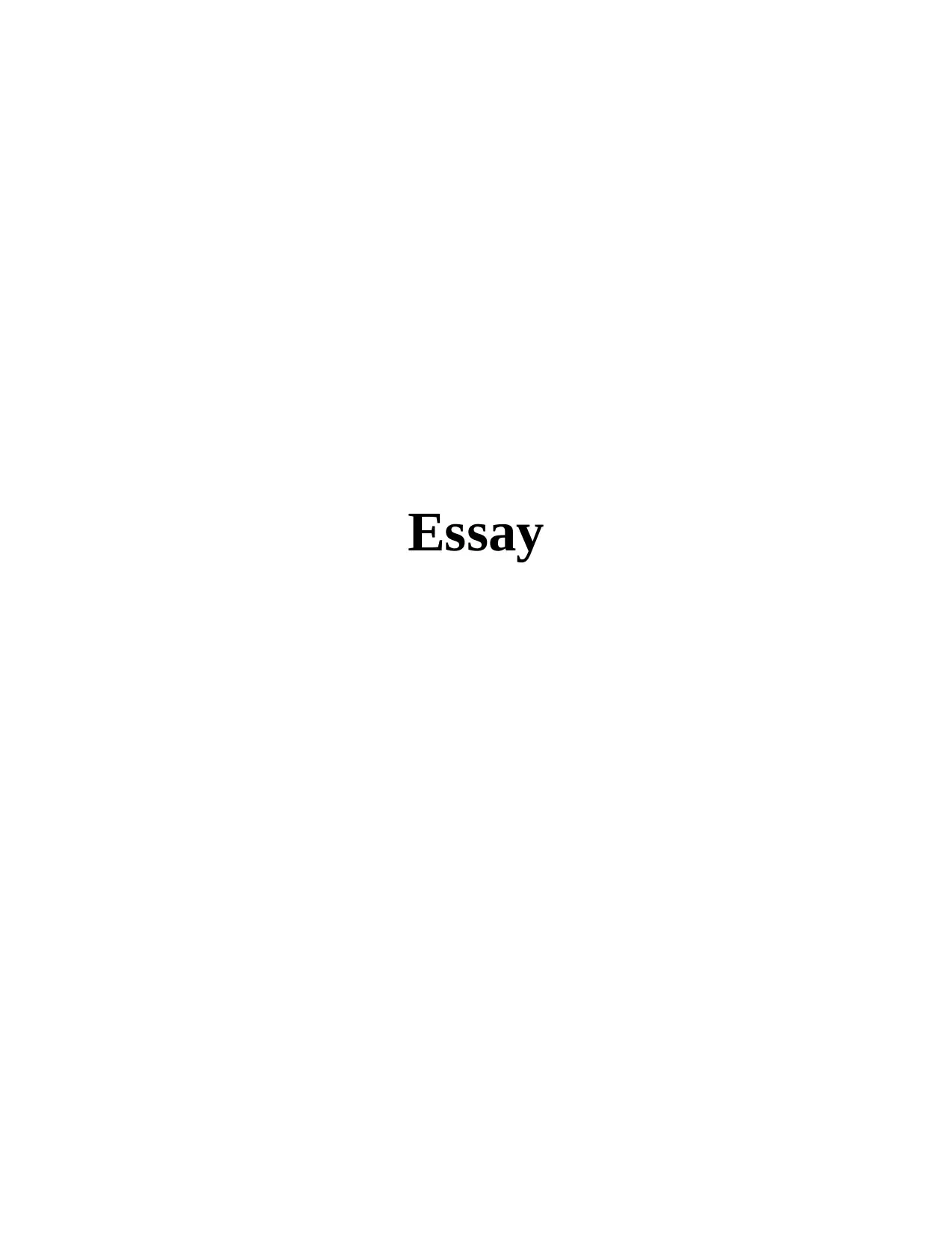
Essay
Paraphrase This Document
Need a fresh take? Get an instant paraphrase of this document with our AI Paraphraser
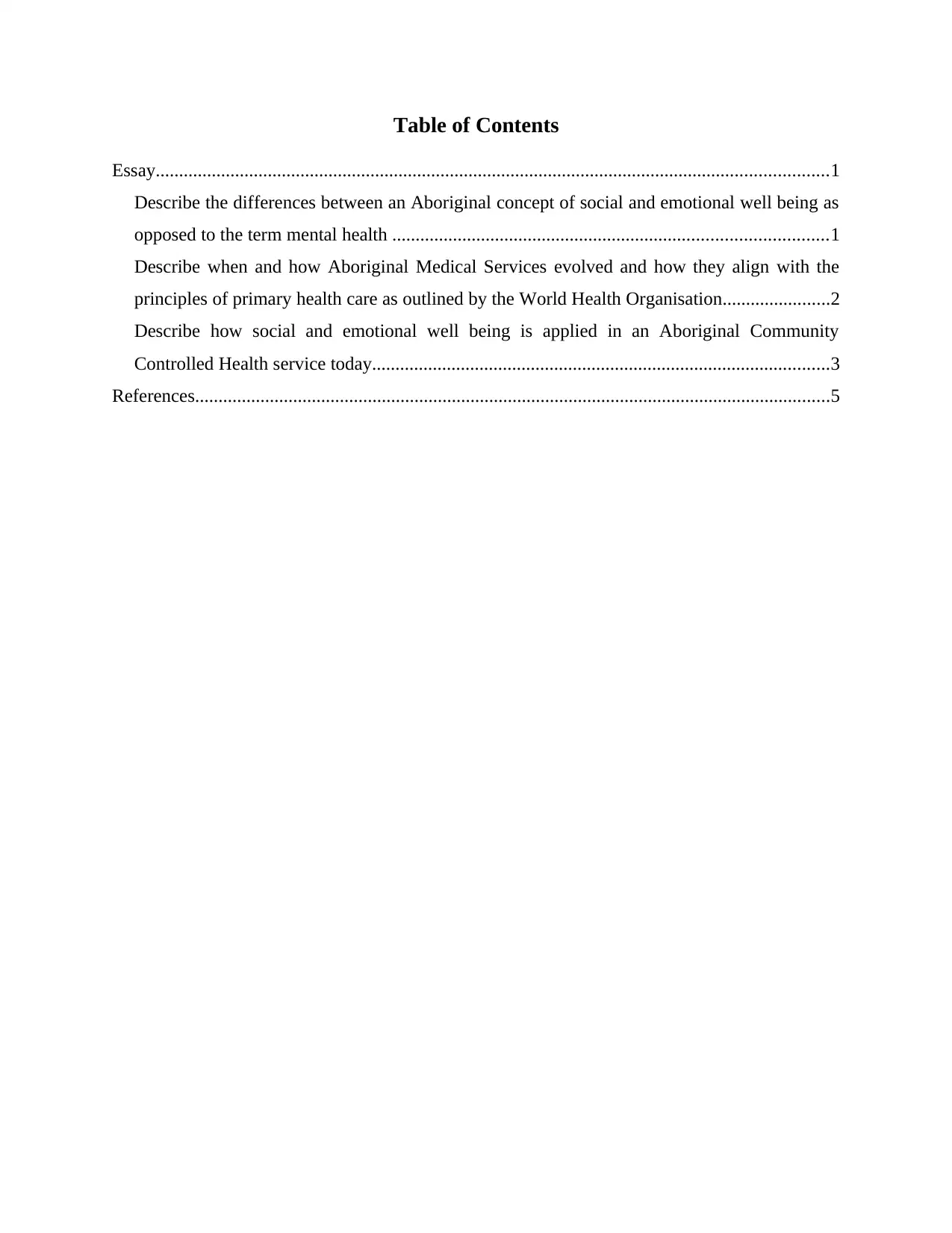
Table of Contents
Essay................................................................................................................................................1
Describe the differences between an Aboriginal concept of social and emotional well being as
opposed to the term mental health .............................................................................................1
Describe when and how Aboriginal Medical Services evolved and how they align with the
principles of primary health care as outlined by the World Health Organisation.......................2
Describe how social and emotional well being is applied in an Aboriginal Community
Controlled Health service today..................................................................................................3
References........................................................................................................................................5
Essay................................................................................................................................................1
Describe the differences between an Aboriginal concept of social and emotional well being as
opposed to the term mental health .............................................................................................1
Describe when and how Aboriginal Medical Services evolved and how they align with the
principles of primary health care as outlined by the World Health Organisation.......................2
Describe how social and emotional well being is applied in an Aboriginal Community
Controlled Health service today..................................................................................................3
References........................................................................................................................................5

⊘ This is a preview!⊘
Do you want full access?
Subscribe today to unlock all pages.

Trusted by 1+ million students worldwide
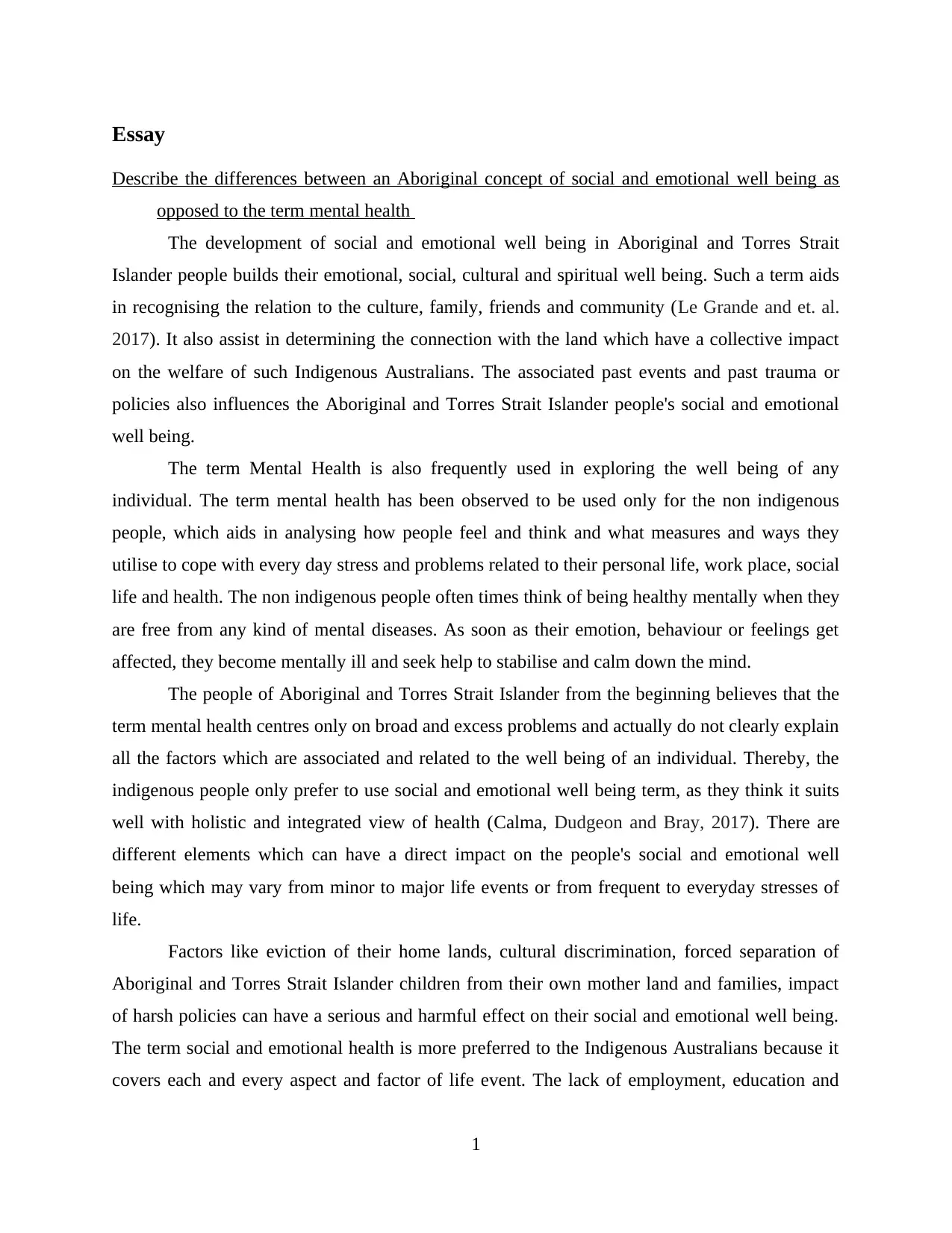
Essay
Describe the differences between an Aboriginal concept of social and emotional well being as
opposed to the term mental health
The development of social and emotional well being in Aboriginal and Torres Strait
Islander people builds their emotional, social, cultural and spiritual well being. Such a term aids
in recognising the relation to the culture, family, friends and community (Le Grande and et. al.
2017). It also assist in determining the connection with the land which have a collective impact
on the welfare of such Indigenous Australians. The associated past events and past trauma or
policies also influences the Aboriginal and Torres Strait Islander people's social and emotional
well being.
The term Mental Health is also frequently used in exploring the well being of any
individual. The term mental health has been observed to be used only for the non indigenous
people, which aids in analysing how people feel and think and what measures and ways they
utilise to cope with every day stress and problems related to their personal life, work place, social
life and health. The non indigenous people often times think of being healthy mentally when they
are free from any kind of mental diseases. As soon as their emotion, behaviour or feelings get
affected, they become mentally ill and seek help to stabilise and calm down the mind.
The people of Aboriginal and Torres Strait Islander from the beginning believes that the
term mental health centres only on broad and excess problems and actually do not clearly explain
all the factors which are associated and related to the well being of an individual. Thereby, the
indigenous people only prefer to use social and emotional well being term, as they think it suits
well with holistic and integrated view of health (Calma, Dudgeon and Bray, 2017). There are
different elements which can have a direct impact on the people's social and emotional well
being which may vary from minor to major life events or from frequent to everyday stresses of
life.
Factors like eviction of their home lands, cultural discrimination, forced separation of
Aboriginal and Torres Strait Islander children from their own mother land and families, impact
of harsh policies can have a serious and harmful effect on their social and emotional well being.
The term social and emotional health is more preferred to the Indigenous Australians because it
covers each and every aspect and factor of life event. The lack of employment, education and
1
Describe the differences between an Aboriginal concept of social and emotional well being as
opposed to the term mental health
The development of social and emotional well being in Aboriginal and Torres Strait
Islander people builds their emotional, social, cultural and spiritual well being. Such a term aids
in recognising the relation to the culture, family, friends and community (Le Grande and et. al.
2017). It also assist in determining the connection with the land which have a collective impact
on the welfare of such Indigenous Australians. The associated past events and past trauma or
policies also influences the Aboriginal and Torres Strait Islander people's social and emotional
well being.
The term Mental Health is also frequently used in exploring the well being of any
individual. The term mental health has been observed to be used only for the non indigenous
people, which aids in analysing how people feel and think and what measures and ways they
utilise to cope with every day stress and problems related to their personal life, work place, social
life and health. The non indigenous people often times think of being healthy mentally when they
are free from any kind of mental diseases. As soon as their emotion, behaviour or feelings get
affected, they become mentally ill and seek help to stabilise and calm down the mind.
The people of Aboriginal and Torres Strait Islander from the beginning believes that the
term mental health centres only on broad and excess problems and actually do not clearly explain
all the factors which are associated and related to the well being of an individual. Thereby, the
indigenous people only prefer to use social and emotional well being term, as they think it suits
well with holistic and integrated view of health (Calma, Dudgeon and Bray, 2017). There are
different elements which can have a direct impact on the people's social and emotional well
being which may vary from minor to major life events or from frequent to everyday stresses of
life.
Factors like eviction of their home lands, cultural discrimination, forced separation of
Aboriginal and Torres Strait Islander children from their own mother land and families, impact
of harsh policies can have a serious and harmful effect on their social and emotional well being.
The term social and emotional health is more preferred to the Indigenous Australians because it
covers each and every aspect and factor of life event. The lack of employment, education and
1
Paraphrase This Document
Need a fresh take? Get an instant paraphrase of this document with our AI Paraphraser
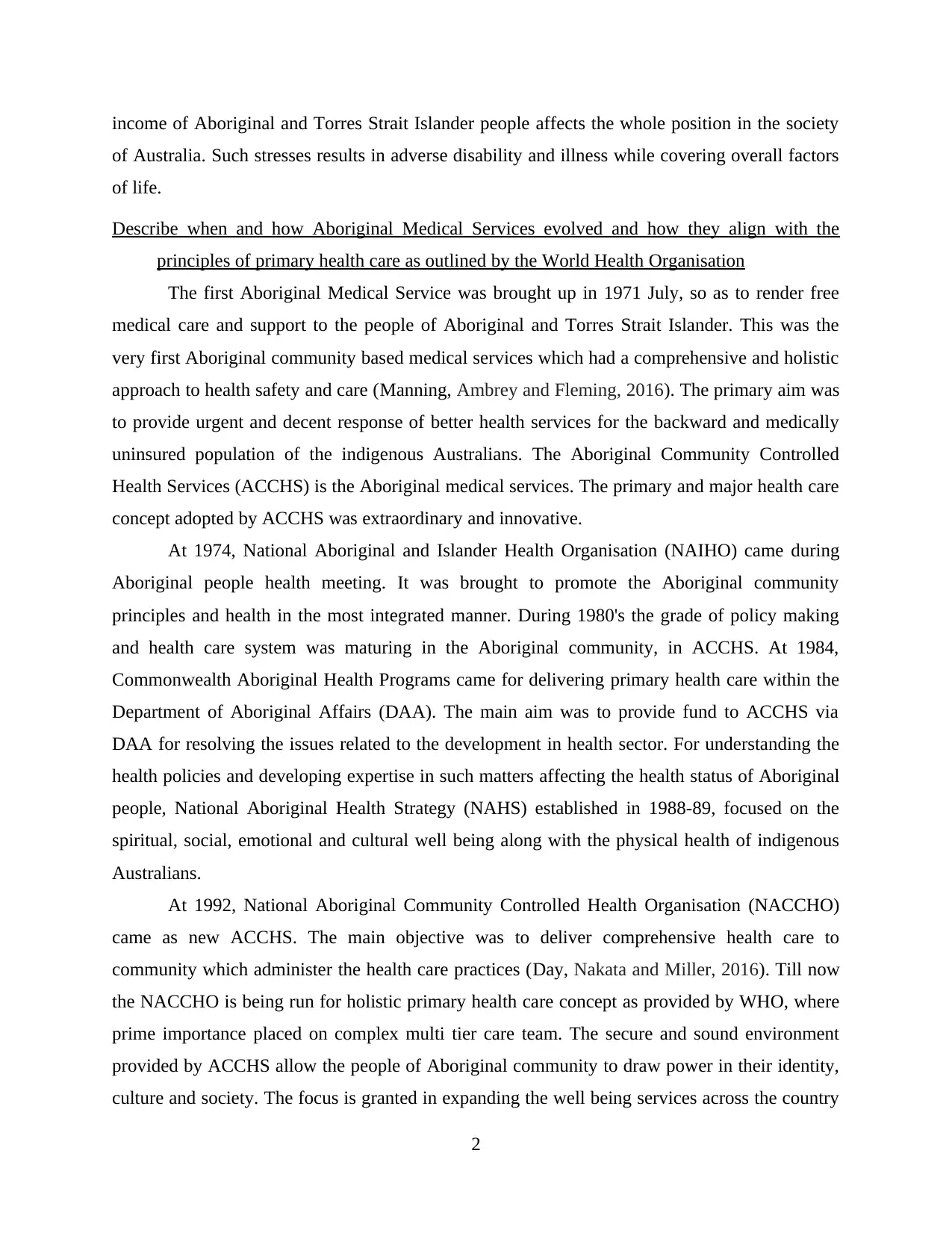
income of Aboriginal and Torres Strait Islander people affects the whole position in the society
of Australia. Such stresses results in adverse disability and illness while covering overall factors
of life.
Describe when and how Aboriginal Medical Services evolved and how they align with the
principles of primary health care as outlined by the World Health Organisation
The first Aboriginal Medical Service was brought up in 1971 July, so as to render free
medical care and support to the people of Aboriginal and Torres Strait Islander. This was the
very first Aboriginal community based medical services which had a comprehensive and holistic
approach to health safety and care (Manning, Ambrey and Fleming, 2016). The primary aim was
to provide urgent and decent response of better health services for the backward and medically
uninsured population of the indigenous Australians. The Aboriginal Community Controlled
Health Services (ACCHS) is the Aboriginal medical services. The primary and major health care
concept adopted by ACCHS was extraordinary and innovative.
At 1974, National Aboriginal and Islander Health Organisation (NAIHO) came during
Aboriginal people health meeting. It was brought to promote the Aboriginal community
principles and health in the most integrated manner. During 1980's the grade of policy making
and health care system was maturing in the Aboriginal community, in ACCHS. At 1984,
Commonwealth Aboriginal Health Programs came for delivering primary health care within the
Department of Aboriginal Affairs (DAA). The main aim was to provide fund to ACCHS via
DAA for resolving the issues related to the development in health sector. For understanding the
health policies and developing expertise in such matters affecting the health status of Aboriginal
people, National Aboriginal Health Strategy (NAHS) established in 1988-89, focused on the
spiritual, social, emotional and cultural well being along with the physical health of indigenous
Australians.
At 1992, National Aboriginal Community Controlled Health Organisation (NACCHO)
came as new ACCHS. The main objective was to deliver comprehensive health care to
community which administer the health care practices (Day, Nakata and Miller, 2016). Till now
the NACCHO is being run for holistic primary health care concept as provided by WHO, where
prime importance placed on complex multi tier care team. The secure and sound environment
provided by ACCHS allow the people of Aboriginal community to draw power in their identity,
culture and society. The focus is granted in expanding the well being services across the country
2
of Australia. Such stresses results in adverse disability and illness while covering overall factors
of life.
Describe when and how Aboriginal Medical Services evolved and how they align with the
principles of primary health care as outlined by the World Health Organisation
The first Aboriginal Medical Service was brought up in 1971 July, so as to render free
medical care and support to the people of Aboriginal and Torres Strait Islander. This was the
very first Aboriginal community based medical services which had a comprehensive and holistic
approach to health safety and care (Manning, Ambrey and Fleming, 2016). The primary aim was
to provide urgent and decent response of better health services for the backward and medically
uninsured population of the indigenous Australians. The Aboriginal Community Controlled
Health Services (ACCHS) is the Aboriginal medical services. The primary and major health care
concept adopted by ACCHS was extraordinary and innovative.
At 1974, National Aboriginal and Islander Health Organisation (NAIHO) came during
Aboriginal people health meeting. It was brought to promote the Aboriginal community
principles and health in the most integrated manner. During 1980's the grade of policy making
and health care system was maturing in the Aboriginal community, in ACCHS. At 1984,
Commonwealth Aboriginal Health Programs came for delivering primary health care within the
Department of Aboriginal Affairs (DAA). The main aim was to provide fund to ACCHS via
DAA for resolving the issues related to the development in health sector. For understanding the
health policies and developing expertise in such matters affecting the health status of Aboriginal
people, National Aboriginal Health Strategy (NAHS) established in 1988-89, focused on the
spiritual, social, emotional and cultural well being along with the physical health of indigenous
Australians.
At 1992, National Aboriginal Community Controlled Health Organisation (NACCHO)
came as new ACCHS. The main objective was to deliver comprehensive health care to
community which administer the health care practices (Day, Nakata and Miller, 2016). Till now
the NACCHO is being run for holistic primary health care concept as provided by WHO, where
prime importance placed on complex multi tier care team. The secure and sound environment
provided by ACCHS allow the people of Aboriginal community to draw power in their identity,
culture and society. The focus is granted in expanding the well being services across the country
2
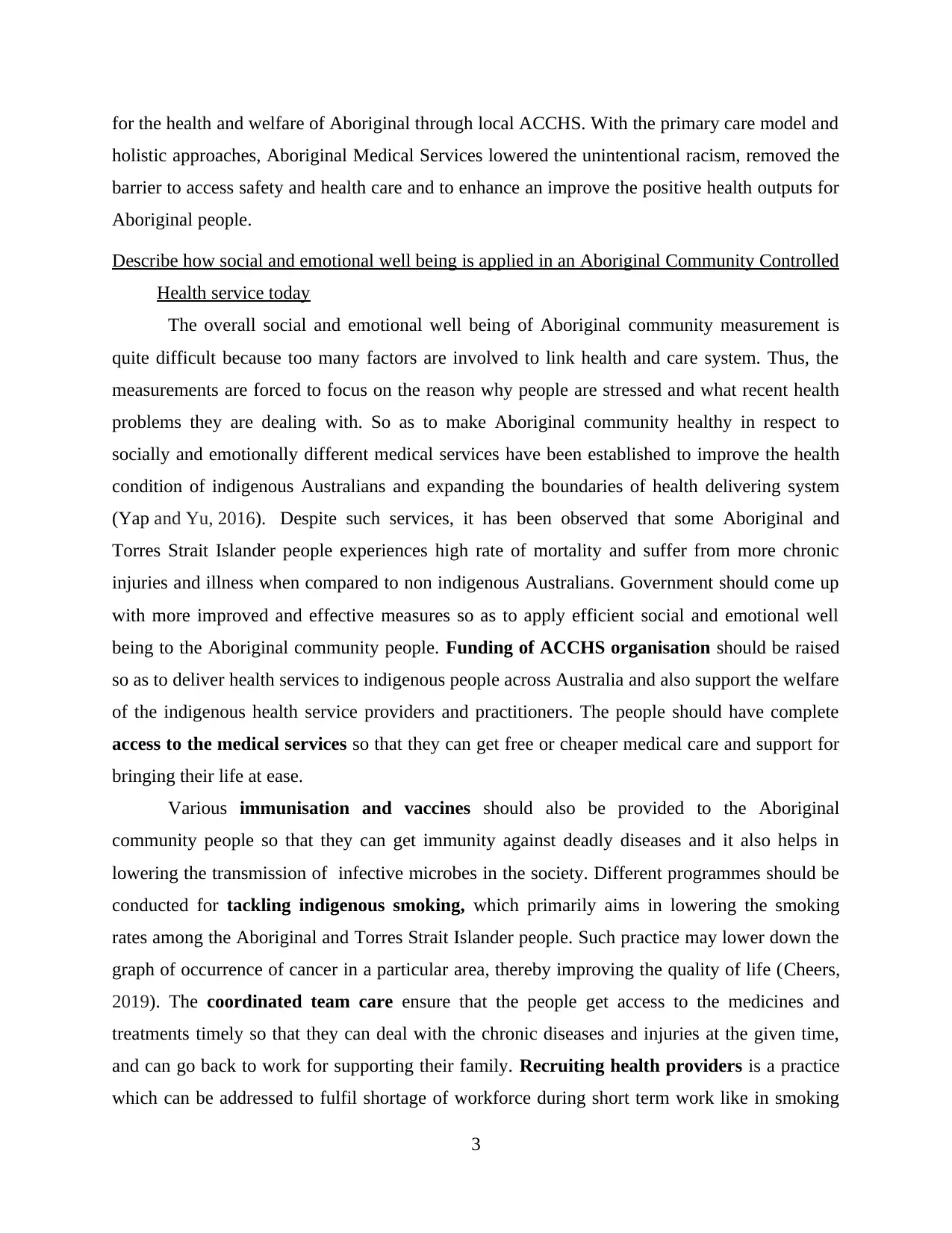
for the health and welfare of Aboriginal through local ACCHS. With the primary care model and
holistic approaches, Aboriginal Medical Services lowered the unintentional racism, removed the
barrier to access safety and health care and to enhance an improve the positive health outputs for
Aboriginal people.
Describe how social and emotional well being is applied in an Aboriginal Community Controlled
Health service today
The overall social and emotional well being of Aboriginal community measurement is
quite difficult because too many factors are involved to link health and care system. Thus, the
measurements are forced to focus on the reason why people are stressed and what recent health
problems they are dealing with. So as to make Aboriginal community healthy in respect to
socially and emotionally different medical services have been established to improve the health
condition of indigenous Australians and expanding the boundaries of health delivering system
(Yap and Yu, 2016). Despite such services, it has been observed that some Aboriginal and
Torres Strait Islander people experiences high rate of mortality and suffer from more chronic
injuries and illness when compared to non indigenous Australians. Government should come up
with more improved and effective measures so as to apply efficient social and emotional well
being to the Aboriginal community people. Funding of ACCHS organisation should be raised
so as to deliver health services to indigenous people across Australia and also support the welfare
of the indigenous health service providers and practitioners. The people should have complete
access to the medical services so that they can get free or cheaper medical care and support for
bringing their life at ease.
Various immunisation and vaccines should also be provided to the Aboriginal
community people so that they can get immunity against deadly diseases and it also helps in
lowering the transmission of infective microbes in the society. Different programmes should be
conducted for tackling indigenous smoking, which primarily aims in lowering the smoking
rates among the Aboriginal and Torres Strait Islander people. Such practice may lower down the
graph of occurrence of cancer in a particular area, thereby improving the quality of life (Cheers,
2019). The coordinated team care ensure that the people get access to the medicines and
treatments timely so that they can deal with the chronic diseases and injuries at the given time,
and can go back to work for supporting their family. Recruiting health providers is a practice
which can be addressed to fulfil shortage of workforce during short term work like in smoking
3
holistic approaches, Aboriginal Medical Services lowered the unintentional racism, removed the
barrier to access safety and health care and to enhance an improve the positive health outputs for
Aboriginal people.
Describe how social and emotional well being is applied in an Aboriginal Community Controlled
Health service today
The overall social and emotional well being of Aboriginal community measurement is
quite difficult because too many factors are involved to link health and care system. Thus, the
measurements are forced to focus on the reason why people are stressed and what recent health
problems they are dealing with. So as to make Aboriginal community healthy in respect to
socially and emotionally different medical services have been established to improve the health
condition of indigenous Australians and expanding the boundaries of health delivering system
(Yap and Yu, 2016). Despite such services, it has been observed that some Aboriginal and
Torres Strait Islander people experiences high rate of mortality and suffer from more chronic
injuries and illness when compared to non indigenous Australians. Government should come up
with more improved and effective measures so as to apply efficient social and emotional well
being to the Aboriginal community people. Funding of ACCHS organisation should be raised
so as to deliver health services to indigenous people across Australia and also support the welfare
of the indigenous health service providers and practitioners. The people should have complete
access to the medical services so that they can get free or cheaper medical care and support for
bringing their life at ease.
Various immunisation and vaccines should also be provided to the Aboriginal
community people so that they can get immunity against deadly diseases and it also helps in
lowering the transmission of infective microbes in the society. Different programmes should be
conducted for tackling indigenous smoking, which primarily aims in lowering the smoking
rates among the Aboriginal and Torres Strait Islander people. Such practice may lower down the
graph of occurrence of cancer in a particular area, thereby improving the quality of life (Cheers,
2019). The coordinated team care ensure that the people get access to the medicines and
treatments timely so that they can deal with the chronic diseases and injuries at the given time,
and can go back to work for supporting their family. Recruiting health providers is a practice
which can be addressed to fulfil shortage of workforce during short term work like in smoking
3
⊘ This is a preview!⊘
Do you want full access?
Subscribe today to unlock all pages.

Trusted by 1+ million students worldwide
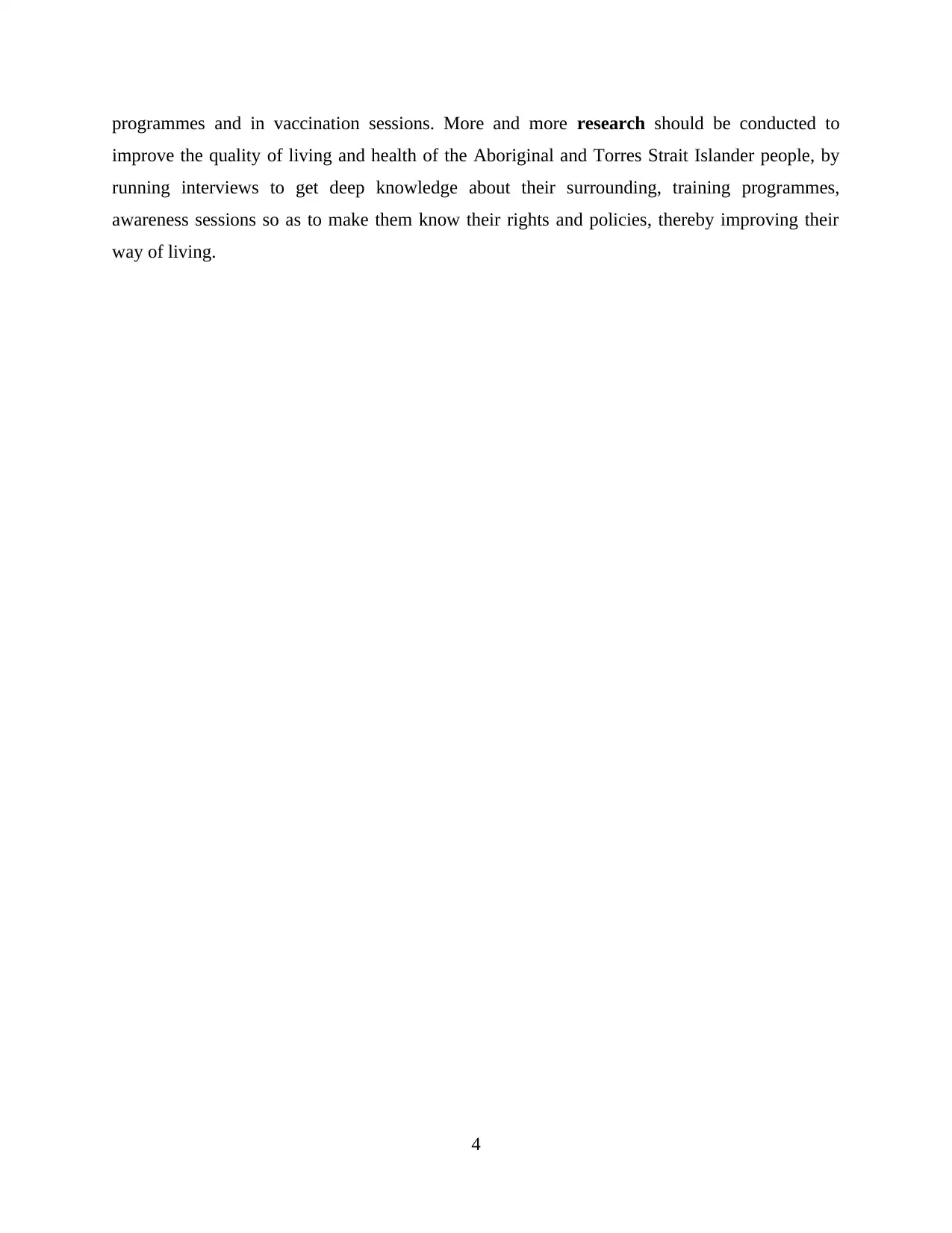
programmes and in vaccination sessions. More and more research should be conducted to
improve the quality of living and health of the Aboriginal and Torres Strait Islander people, by
running interviews to get deep knowledge about their surrounding, training programmes,
awareness sessions so as to make them know their rights and policies, thereby improving their
way of living.
4
improve the quality of living and health of the Aboriginal and Torres Strait Islander people, by
running interviews to get deep knowledge about their surrounding, training programmes,
awareness sessions so as to make them know their rights and policies, thereby improving their
way of living.
4
Paraphrase This Document
Need a fresh take? Get an instant paraphrase of this document with our AI Paraphraser
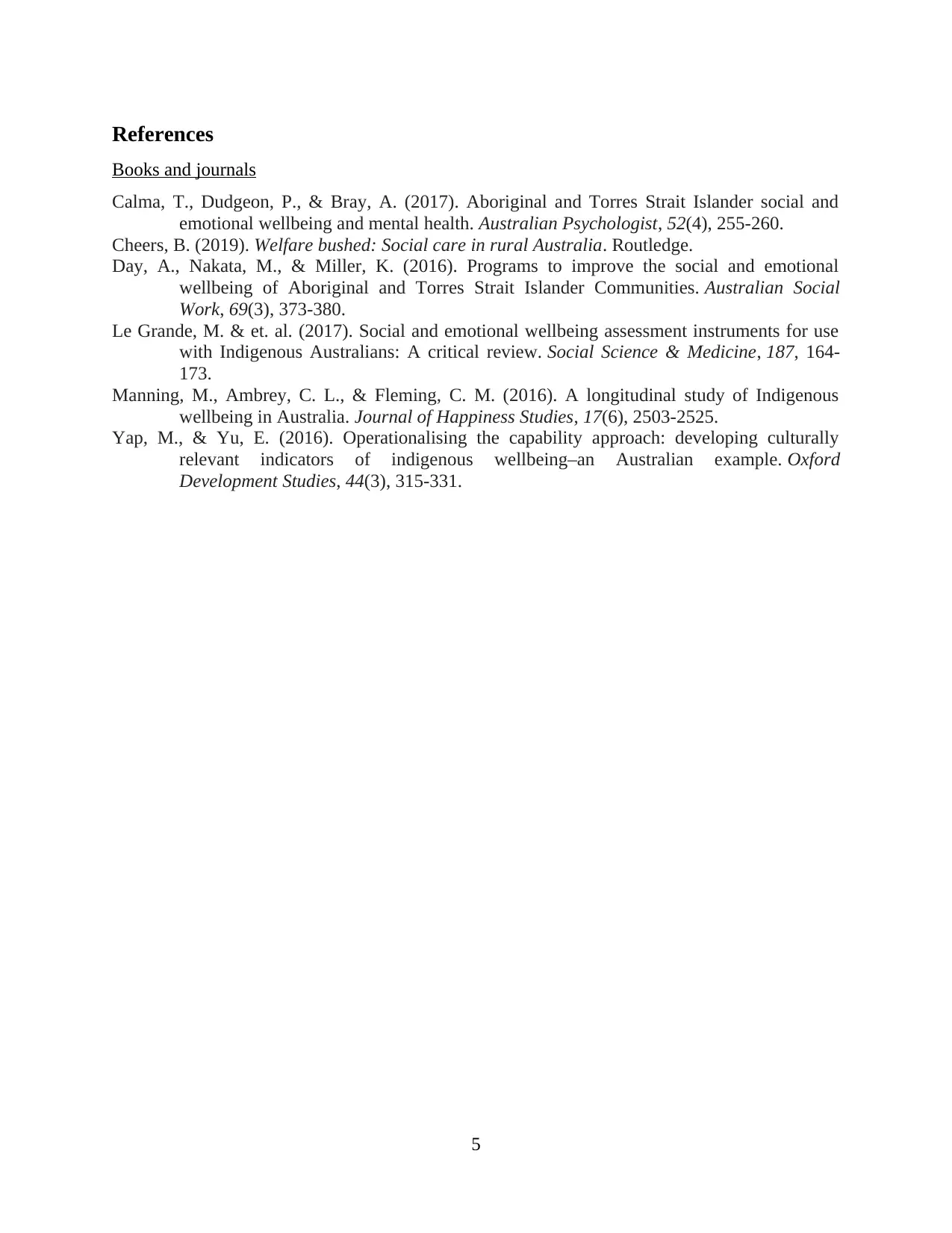
References
Books and journals
Calma, T., Dudgeon, P., & Bray, A. (2017). Aboriginal and Torres Strait Islander social and
emotional wellbeing and mental health. Australian Psychologist, 52(4), 255-260.
Cheers, B. (2019). Welfare bushed: Social care in rural Australia. Routledge.
Day, A., Nakata, M., & Miller, K. (2016). Programs to improve the social and emotional
wellbeing of Aboriginal and Torres Strait Islander Communities. Australian Social
Work, 69(3), 373-380.
Le Grande, M. & et. al. (2017). Social and emotional wellbeing assessment instruments for use
with Indigenous Australians: A critical review. Social Science & Medicine, 187, 164-
173.
Manning, M., Ambrey, C. L., & Fleming, C. M. (2016). A longitudinal study of Indigenous
wellbeing in Australia. Journal of Happiness Studies, 17(6), 2503-2525.
Yap, M., & Yu, E. (2016). Operationalising the capability approach: developing culturally
relevant indicators of indigenous wellbeing–an Australian example. Oxford
Development Studies, 44(3), 315-331.
5
Books and journals
Calma, T., Dudgeon, P., & Bray, A. (2017). Aboriginal and Torres Strait Islander social and
emotional wellbeing and mental health. Australian Psychologist, 52(4), 255-260.
Cheers, B. (2019). Welfare bushed: Social care in rural Australia. Routledge.
Day, A., Nakata, M., & Miller, K. (2016). Programs to improve the social and emotional
wellbeing of Aboriginal and Torres Strait Islander Communities. Australian Social
Work, 69(3), 373-380.
Le Grande, M. & et. al. (2017). Social and emotional wellbeing assessment instruments for use
with Indigenous Australians: A critical review. Social Science & Medicine, 187, 164-
173.
Manning, M., Ambrey, C. L., & Fleming, C. M. (2016). A longitudinal study of Indigenous
wellbeing in Australia. Journal of Happiness Studies, 17(6), 2503-2525.
Yap, M., & Yu, E. (2016). Operationalising the capability approach: developing culturally
relevant indicators of indigenous wellbeing–an Australian example. Oxford
Development Studies, 44(3), 315-331.
5
1 out of 8
Related Documents
Your All-in-One AI-Powered Toolkit for Academic Success.
+13062052269
info@desklib.com
Available 24*7 on WhatsApp / Email
![[object Object]](/_next/static/media/star-bottom.7253800d.svg)
Unlock your academic potential
Copyright © 2020–2025 A2Z Services. All Rights Reserved. Developed and managed by ZUCOL.





